Grammar: Groups & phrases: Verb group: Structure of the verb group
| Overview |
Function and structure of the verb group
The function of the verb group in the clause is to express the happening or Process:
The children chased the ghost.
Doer Process Done-To
In this example the verb group chased expresses what is happening in the clause. We express different kinds of 'happenings' through verbs of thinking, feeling, saying, naming and describing. All such verbs are 'lexical' verbs, ie they have a meaning we can look up in a dictionary. However, a verb group is typically made up of a lexical verb, which is the 'main' verb in a verb group, and 'auxiliary' verbs of various types, and it may even have two main verbs as well as auxiliary verbs. In other words, the verb group has a structure which is made up of different elements or forms. These forms perform different functions in the verb group, whereas the verb group as a whole performs a particular function in the clause, ie it expresses the Process or happening.
The structure of a verb group may be very simple, consisting of just a main verb:
|
Granny Gong chased the ghost around the flat. |

|
But the verb group structure may also be very complex, consisting of a main verb plus a mixture of 'auxiliary verbs' (have, be), the 'do auxiliary verb' and one of a number of 'modal auxiliary verbs' (can, could, may, might), and even an expression of 'negative polarity':
Granny Gong should not have been chasing the ghost around the flat.
v e r b g r o u p
In addition to the complexity created by the different types and the number of auxiliaries that may be part of the verb group, the main verb itself may be 'complex', ie it may consist of a verb + particle (phrasal verb) or of more than one verb (double verb construction), creating a verb group complex:
The plane takes off at 8 o'clock. [phrasal verb]
verb + particle
v e r b g r o u p
Kitty loved eating moon cakes. [double verb construction]
main verb main verb
verb group complex
The basic structure of the verb group has the following sequence:
| modal auxiliary verb (optional) + auxiliary verb (optional) + main verb |
Here are some examples of different combinations of auxiliary verbs with the main verb:
|
Granny Gong has chased the ghost under
the table. |

|
|
The ghost is slipping through Bozo's hands. |
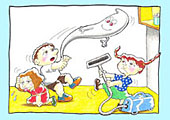
|
We can use the two auxiliaries have and be together:
|
The ghost has
been breaking things. |

|
Another auxiliary verb is the do auxiliary verb, used in two grammatical structures, ie the interrogative and the negative with not:
|
Did Bozo catch the ghost? |

|
|
Granny Gong does not believe the ghost. |
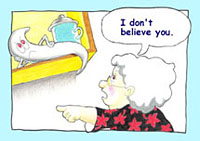
|
In the examples above the do auxiliary expresses no meaning of any kind but simply functions as a 'helper' verb to create a grammatical structure.
However, there are two different uses of do which are 'meaningful': one as auxiliary verb to provide 'emphasis', and the other as main verb to create lexical meaning in conjunction with a noun. In this example the do auxiliary provides emphasis, possibly to counter Granny Gong's disbelief:
|
The ghost did enter the flat through the keyhole. |
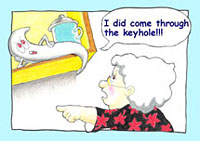
|
In the example below did functions as a main verb. However, it has no
lexical or dictionary meaning of its own. The meaning is created in combination with
the noun homework, ie in this case we could say that the meaning of did + homework is something
like 'homeworked'.
|
Bozo did his homework in class. |
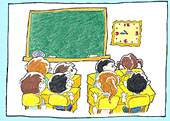
|
Another set of auxiliary verbs are the modal auxiliary verbs (can, could,
may, might, must, will, shall), which we use to express the obligation to do
something, the likelihood of something happening, the inclination and ability to
do something, etc:
"We must catch this ghost," said Granny Gong.
modal aux main verb
v e r b g r o u p
And of course we can combine various auxiliary verbs:
"We should have caught that ghost," said Granny Gong.
modal aux aux main verb
v e r b g r o u p
The auxiliary be is also used to express the 'passive voice':
|
The ghost was caught in a bottle. |
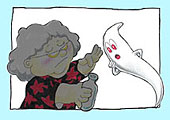
|
|
Granny Gong caught the ghost in a bottle. |
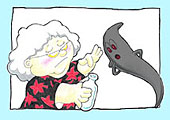
|
Phrasal verbs
'Phrasal verbs' are made up of two or three words which form a short 'phrase' but function like a single lexical verb:
|
Bozo turned on the television. |

|
The phrasal verb turn on means to 'activate', just as turn off means to 'deactivate'.
|
Ricky knocked over a glass. |
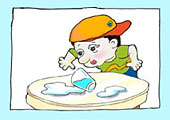
|
The phrasal verb knock over means to 'upset' some physical object, like a glass or even a person.
Phrasal verbs are formed with prepositions and adverbs but since these two word classes overlap, we use the term 'particle' for both except when we need to make a distinction.
Phrasal verbs, especially those formed with adverbs, can often be replaced by a single verb with similar meaning (bring back = 'return', hand over = 'give'). Sometimes the meaning of a phrasal verb may be guessed but they are much better learned as a single unit.
Double verb constructions
Combinations of two lexical verbs are very common in English:
Granny Gong tried to catch the ghost.
main verb particle main verb
v e r b g r o u pKitty likes playing computer games.
main verb main verb
v e r b g r o u p
The second lexical verb is either in the to + base form or the -ing form. These two forms differ in meaning, in these examples by contrasting 'intention' (tries to + base verb) with 'action' (likes + -ing form).
| For a summary of the relationship between the forms and functions of the
elements of the verb group, click here: |
 |
|
Alternative terms |
|
| PrimeGram | Other grammars |
| verb group | verb/verbal phrase |
|
||
To give us feedback about this section, click here or on the Comment button at the top of the screen.
If you have any questions about this section, visit the Language Corner.
If you have any questions or suggestions about how to teach this section, send a message to the Teaching Corner.